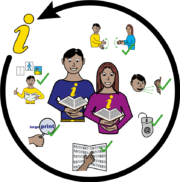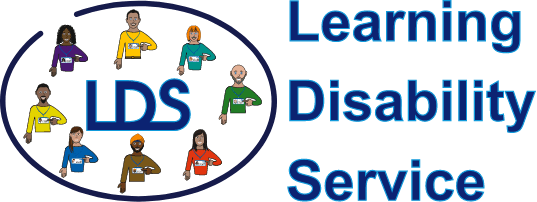

Welcome to the Accessible Information Standard Resources!
This area of the site focuses on resources aimed at helping health and social care organisations use easy read as part of their work to meet the Accessible Information Standard.
The Accessible Information Standard is to make sure that people who have a disability, impairment or sensory loss are given information they can easily read or understand. It makes it clear that NHS and adult social care organisations must make sure people get information in different formats that meet their needs, for example easy read.
- What is the Accessible Information Standard?
- What is accessible information?
- What is easy read?
We hope these resources will provide a quick and easy way of finding out what the standard is and how you might use and create easy read resources to meet it.
Within the easy on the i area of our website you will see that we offer thousands of images within our image bank that can be used to help create easy read resources. It’s completely free, all you need to do is register. Within our get checked out and get me better you will also find lots of ready made resources which you might find useful as either examples or to put into use yourself.
If you have any comments or suggestions please feel free to get in touch at easyonthei.lypft@nhs.net
What is accessible information?
Accessible information is information that you can understand. What makes information accessible is different for different people; there is no one size fits all as people often have different needs.
Most people are aware that there are lots of different ways of making information more accessible. This is why it is important to know the needs of the people or person your information is for. People may need information presented in a particular way because of a particular impairment. Examples might include visual impairment, hearing impairment or a learning disability. It might be necessary to offer spoken versions, braille, phone calls, sign language, Makaton or easy read to make information accessible.
There are a many ways of making information more accessible, the key is to find out what the people your information is for need and offer it.
Ask yourself these questions:
- Who is the information for?
- Will the information be useful to them?
- How should the information be provided?
and use the answers to help guide you in making information accessible.
The standard requires that health and social care organisations do 5 things
- Ask people if they have any information or communication needs and how they can meet these.
- Record those needs clearly and in a set way.
- Highlight or flag the person’s file or notes so it is clear they have communication needs and how these needs can be met.
- Share their knowledge of a person’s information or communication needs with other providers of NHS and adult social care services if they have consent or permission to.
- Take steps to make sure people receive information that they can access and understand and that they are given communication support if they need it.
What is the Accessible Information Standard?
All organisations that provide NHS or adult social care must follow the accessible information standard by law.
This includes NHS Trusts and GP practices.
The accessible information standard tells organisations how they should make sure that they provide information which is easy to access and understand to all;
- patients and service users
- carers and parents
This includes making sure that people get information in the way that suits them best. Examples can include;
- large print
- braille
- easy read
- by email
The standard also describes how to support people’s communication needs, for example by offering help from an advocate or British Sign Language interpreter.
What is easy read?
Easy read is just one way of making information more accessible. It is a style of information often chosen by people with learning disabilities, although other groups can find it useful too.
There is no one way to make written information easy read but there are some general guidelines that are usually followed;
- Who is the information for?
- Using easy words
- Use images to support the text
- Large print
- Plain fonts
- Short sentences
Of course easy read might not be the best choice for someone. Not everyone with a learning disability will find easy read useful. For some people it might be easier to talk to someone, or watch a video.
For more information on producing easy read try looking at our new guide and PowerPoint. You can use these to teach yourself how to produce easy read or you can use them to help train others too. Don’t forget that we also have other guides on the easy on the I ‘How to Use’ page as well, including links to advice from other organisations. You can also register for our free image bank for resources that you might find useful.
If you can’t find exactly what you need you can find other information on producing easy read on our easy on the i image bank page or by visiting some of the places on our easy on the i links page.

